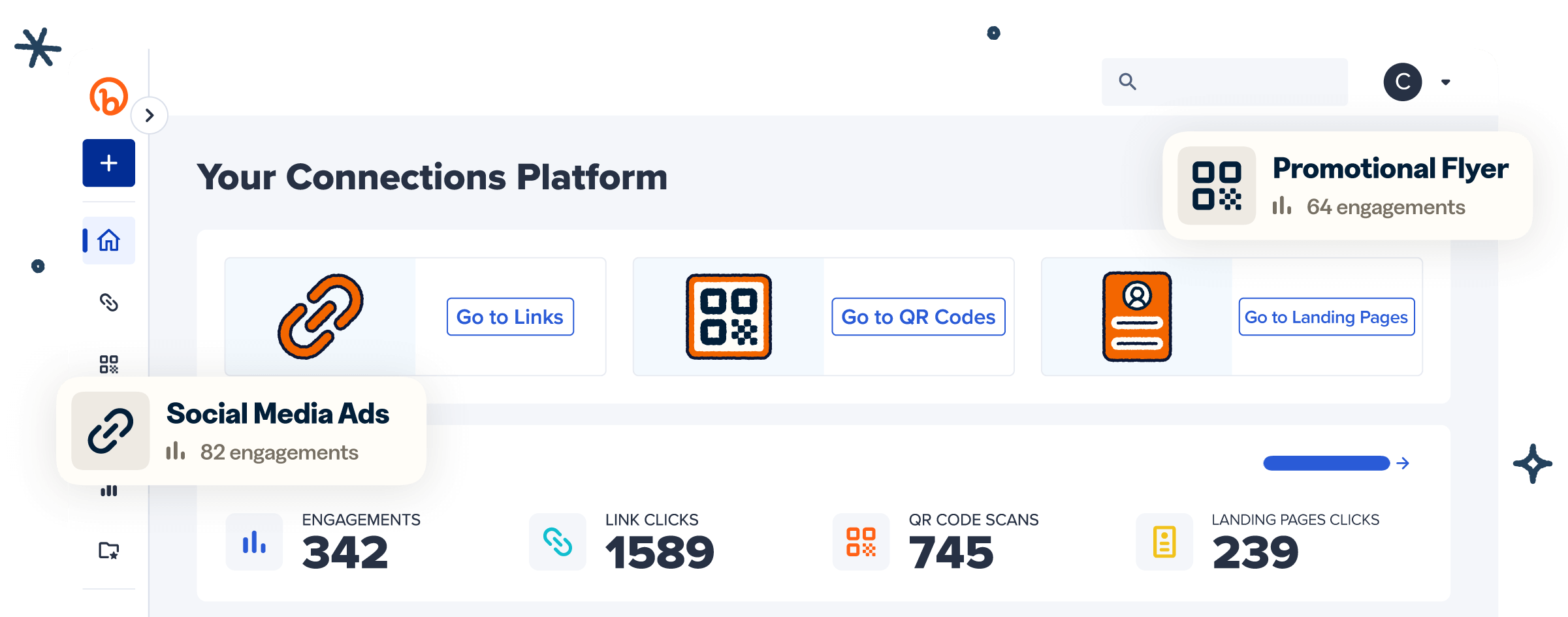If you visited a new doctor for a physical but she had a poor bedside manner, you probably wouldn’t go back again, right? But a barista who goes out of his way to remember your coffee order and suggest complementary items just might make you a permanent regular at your local cafe.
For service providers and businesses alike, a top-notch offering is all-important. But it’s what happens before, during, and after someone buys or engages with your business can turn them into a lifelong fan. That’s the power of customer engagement. Let’s break down what customer engagement is, trends in 2024, and tips to level up your customer connection.
Customer engagement 101
Loyalty programs. Creative brand activations. Customer support and surveys. All of these touchpoints and more play a part in your customer engagement strategy.
Customer engagement is how a brand connects and interacts with its customers across channels and offers them value beyond its product or service. Your customer engagement strategy invites two-way dialogue with your audience and deepens your relationship. They also boost your bottom line by:
- Driving revenue through retention, upsells, and repeat purchases
- Inspiring word-of-mouth marketing and personal recommendations
- Building brand awareness, recognition, and loyalty
When brands go above and beyond to connect with their audience, customers take note. These strategies pay back dividends, both in measurable sales revenue and in intangible positive sentiment toward your brand. It’s always worth investing in customer engagement.
2024 trends in customer engagement
Customer engagement has never been as “real-time” as it is now. New and evolving consumer expectations mean that brands across every industry need to engage audiences in new ways. The same-old approaches and tactics that worked 10 years ago (or even two years ago) won’t cut it today.
Here are five of the big-picture customer engagement trends in 2024.
Personalization at scale (but with a twist)
For years, personalization has been a top and growing priority for brands eager to engage their audience, make customers feel known, and customize marketing to the individual. But personalized marketing has advanced in leaps and bounds in the last two years thanks to the rapid evolution of generative AI.
Armed with AI’s masterful ability to process customer data on a large scale, brands are equipped to personalize campaigns like never before. AI is only as good as the data it’s been fed, though. Marketers need an airtight data strategy to capture customer behavior, analyze data, and understand their audience.
Personalization remains a core tenet of good marketing. But the trend is finding new ways to gather data, leverage new and emerging tools, and personalize their offerings at scale. In 2024 and beyond, an engaging message is a personalized one.
Omnichannel engagement
Omnichannel marketing used to be primarily a retail concept designed to unify online shopping experiences with in-person offerings. But in 2024, brands in every industry work to integrate customer experiences across channels so that they complement each other and so that each one furthers engagement.
On a recent episode of the Winning With Shopify podcast, host Nick Trueman shared a recent example of omnichannel marketing that he experienced. He placed an order for desks for his office and signed up for text messages but didn’t create an account initially. After his order was placed, the brand:
- Texted him a link to track the delivery’s journey to him.
- Recommended products on the tracking landing page, offering free shipping and 30% off of any additional items he purchased before delivery.
- Texted him the day of the delivery, which prompted him to create an account. This time, he opted into email communication.
- Gave him loyalty points and discounts in his newly created account.
Each channel throughout his purchase enhanced the others. “It’s important to have an omnichannel approach, whether it’s push notification, SMS, or email,” Nick says. To drive more sales and connect with customers on a deeper level, consider how your channels can enhance each other.

Community building
The companies that customers love in 2024 foster community between the people who use their product or service.
This year’s release of Taylor Swift’s album, The Tortured Poets Department, is the perfect example—and she made the most of her community with a viral QR Code campaign. The superstar’s brand engaged Swifties with a shared challenge that encouraged them to work together and bond over their excitement along the way.
This trend isn’t just for B2C or entertainment brands, either—B2B brands have superfans and can rally their community around them, too.
“When people love brands, [they exhibit] attachment to their identity—it becomes part of how they define themselves, whether in the workplace, as an individual, or the whole company,” said Mariya Delano, founder of Kalyna Marketing, in a session at B2BSMX. For instance, software brands can create communities for group learning and best practice sharing among their power users like Salesforce Trailblazers or certification programs like HubSpot Academy.
No matter your industry, find your superfans and foster a community to keep them engaged.
Sustainable and ethical engagement
The bar for brands’ behavior has been rising for a while, and consumers are concerned citizens when it comes to companies’ sustainability and ethics. Digital tech has ushered in all-new levels of accountability for brands. Consumers can now conduct in-depth research to expose brands’ exact carbon footprint or employee working conditions. This is a major alarm bell for companies with practices they want to hide.
But for companies willing to be transparent, it’s a chance to shine and stand out. Ethical engagement in 2024 looks like:
- Sharing about your green manufacturing practices
- Inviting customers to contribute to or share your favorite causes
- Showing the positive impact of buying a single product
- Educating customers on how to dispose of packaging with a QR Code or short link
Every ethical choice companies make can endear customers to their brand and invite them into a lasting relationship.
Interactive and immersive experiences
Marketing used to be a “one-to-many” activity, but today, consumers expect communication to happen in both directions. They don’t just want to hear from brands—they want to participate in fun, unique, and interactive experiences. That’s why more and more brands are embracing the power of QR Codes on:
Customers can scan from their smartphones and take charge of interactions with brands, seek out information, and even provide feedback in real time.
Some brands are taking “interactivity” to the next level with unforgettable and immersive brand experiences. From special Augmented Reality (AR) and Virtual Reality (VR) brand moments to gamification like scavenger hunts, brands need to engage their audience in immersive activities that are playful, shareable, and memorable.
6 customer engagement best practices
How can you put these engagement trends into action for your brand? Here are six tips to connect with your customers and turn them into fans for life.
1. Offer value at important milestones
One of the keys to customer engagement is to provide value to your audience at milestone moments before, during, or after interactions with your brand. Identify the touchpoints when customers are most likely to buy from you, browse, share your content, download your app, or take other actions. Then, market to them around those moments:
- Create a post-purchase engagement strategy via email or SMS
- Promote complementary items when they’re likely to reorder using their past behavior
- Engage them after a return with a personalized short link to help them pick out something new
Be sure to segment your outreaches based on their prior orders, browsing activity, and interactions with your brand. When you make customers feel known, the result is connection, engagement, and loyalty.
2. Treat your data as your top tool
Most, if not all, of the top customer engagement trends rely on customer data and analytics. When you’re trying a new tactic or strategy, the most important input is how your customers behave and interact with you.
- Which of your offerings or calls to action are most compelling to your audience? Learn why those resonate, and lean into those strengths.
- Which direct outreaches get the best (and worst) open and clickthrough rates? Use that data to refine the campaigns you send.
- How do people find or follow your brand? Look for the most common referring channels to your short links. (Bitly Analytics has this information!)
When you follow the data and invest in the content, channels, and offerings your customers already enjoy, you’ll drive higher engagement with both your marketing and your brand.

3. Get as close to customers’ problems as you can
Gain critical customer understanding by talking to your customers and walking through their journey with your brand step by step. You’ll uncover pain points and problems you couldn’t capture otherwise, and you can resolve those problems with technology and real-time support.
The endless aisle concept is a great example of a tech-enabled advancement that retailers might not have known about without understanding shoppers’ in-store needs when an item is out of stock or only available at other locations. Now, customers can scan a QR Code in stores to order an item for delivery or pick-up at their preferred store with minimal hassle.
Remove friction by learning everything you can about your customers’ problems—you can even survey them directly by sending a short link via SMS or email. And don’t just ask customers for feedback—make positive changes in response.
4. Bridge physical and digital experiences
Your customers’ behavior constantly bridges the online world and the physical world, so your marketing needs to do the same. Offer convenient ways for audiences to choose their own adventure and connect with your brand online during in-person experiences.
You might provide a QR Code that they can scan to learn more about products and services during an event, order an additional item from their restaurant table, or make a request from their hotel room. As customers change channels, ensure a cohesive, engaging transition that matches customers’ previous behavior or purchases. Leverage data to make sure a digital experience acknowledges and complements whatever experience they’ve had via other channels.
5. Appeal to intrinsic motivation
Simply offering an app, email, or product isn’t enough to engage customers unless you can speak to their motivations and desires. For instance, even if you use a tactic like mobile deep linking to encourage them to download your mobile app, they’ll only keep it if it’s “sticky” enough to convince them to revisit:
- Do you have app-exclusive discounts or menu items?
- Are your weekly merch drops available on the app first?
- Could you leverage gamification to encourage them to log in daily for rewards?
If your customers can get what you offer somewhere else, they probably will. But if you tap into their intrinsic motivation with something of value to them, you’ll see widespread engagement—in your traffic metrics, your sales, and in audience sentiment.
6. Create a sense of belonging
Everyone wants to be a part of something bigger than themselves—and for brands, that instinct is a great way to drive customer engagement. Connect your customers to each other, and tap into the identities that make them your ideal audience.
Hot Topic did this on social media, sharing short links to encourage followers to buy merchandise from their favorite shows. They invited Stranger Things fans to “join” the Hellfire Club, which made them want to be part of a movement within their fandom. Hot Topic focused on the connection between fans by leaning into the age-old Team Jacob and Team Edward debate among Twilight fans and capitalizing on millennial nostalgia for Invader Zim.
Create loyalty programs with chances to win swag to represent your brand, and encourage them to sign up via social on your custom landing page (like Bitly Pages) or each time they make a purchase. Remind your audience what groups they’re part of as a way to keep them engaged.
Connection leads to engaged customers
The stakes for capturing and keeping your audience’s attention are rising. Brands need to think outside the box (and inside their customer’s heads) to start meaningful conversations, make their customers feel something, and provide value beyond the basics.
Look at your customer data first and foremost, and enable engagement with QR Codes and short links that meet your audience with connection and convenience. When you combine those tools with a commitment to your customers, you’ll drive the kind of dynamic, engaging experiences your audience can’t stay away from.


